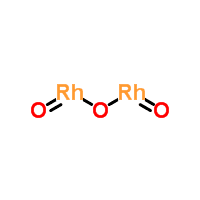Formula Rh2O3 Melting point 1,100 °C Appearance dark grey odorless powder | Molar mass 253.8092 g/mol Density 8.2 g/cm³ Pubchem 159409 | |
 | ||
Synthesis of rhodium iii oxide
Rhodium(III) oxide (or Rhodium sesquioxide) is the chemical compound with the formula Rh2O3.
Contents
Structure
Rh2O3 has been found in two major forms. The hexagonal form has the corundum structure. It transforms into an orthorhombic structure when heated above 750 °C.
Production
Rhodium oxide can be produced via several routes:
Physical properties
Rhodium oxide films behave as a fast two-color electrochromic system: Reversible yellow ↔ dark green or yellow ↔ brown-purple color changes are obtained in KOH solutions by applying voltage ~1 V.
Rhodium oxide films are transparent and conductive, like indium tin oxide (ITO) - the common transparent electrode, but Rh2O3 has 0.2 eV lower work function than ITO. Consequently, deposition of rhodium oxide on ITO improves the carrier injection from ITO thereby improving the electrical properties of organic light-emitting diodes.
Applications
The major application of rhodium oxides is in catalysts (e.g. hydroformylation reactions, N2O production from NO, or the hydrogenation of CO).
Safety
Conditions/substances to avoid when using Rhodium(III) oxide include: extreme heat, hydrochloric acid, hydrosulfuric acid and ammonia.
